KOREAN FURNITURE AVAILABLE ON THE MARKET
In response to various inquiries about Korean furniture in our Facebook group, it seems necessary for us to examine the different types of Korean furniture available on the market.
When looking for genuine pieces, one has to be very careful because, unlike some other forms of art, furniture is seldom signed and is very easy to forge.
The value of antique furniture is greatly determined by its authenticity.
It takes years of practice and the examination of hundreds of pieces.
Train your eyes, use all your senses – smell and touch the material.
Also, consider the country of origin’s history, customs, and geographical data; this is also recommended.
Never forget that no one is infallible, and the mistakes we make help us gain a better understanding.

Sung Sun I Bandaji. Elm wood front. Pine wood body (top, sides & back). Iron fittings, oil finish.
Pakchong area, North Korea.
Mid 19th Century.
H. 96cm, W. 102cm, D. 52cm.

Two units stacked chest, Paulownia wood, iron fittings. Oil finish. Legs restored.
Mid 19th century. Kyonggi province. H. 112cm, W. 77cm, D. 39cm. Collection: “ANTIKASIA“.
This chest, called a “Nong”, is always composed of two identical box units stacked on one another with a stand. It is made from thin boards of Paulownia wood. Iron fittings are used to reinforce its frail structure.
THE FACTS.

Due to the small size of the country and its modest population at the time, original Korean antique furniture is quite rare. Joseon experienced significant demographic change during the 518 years of its existence. At its founding in 1392, the population was about 5.5 million people, and it was around seventeen million at its end in 1910.
Other sources such as studies of the “New International Year Book of Korea” show that the estimated population of Korea was 14,000,000 in 1907, but there has never been a comprehensive census.
The housing census in 1904 reported only 9,500,000 inhabitants for Korea, with Seoul, the capital, having a population between 250,000 and 300,000.
1911: 10,000.000 to 18,000.000
1930: 20,000.000
1944: 25,000.000
Prior to the late 19th century, Korean society was comprised of a ruling class (nobles) and common people, with the middle class being virtually non-existent until the industrialization of the late 19th century.
It is, therefore, easy to understand the rarity of original Korean pieces compared to its neighbors China and even Japan, where the population was significantly larger.

DESIGN IDENTIFICATION OF KOREAN CLOTHING CHESTS.
In this post, we will only focus on clothing chests, which are among the most readily available pieces on the market today. Our study starts with a reminder of the general design of each piece when found in its original condition.


1- THE BANDAJI: Simple trunk of rectangular shape with a front
panel opening downward. Made of thick and wide wooden boards
and decorated with more or less metal plates .
Average size: H. 70cm, L. 90cm, D. 40cm


2- THE MORIJANG: A small chest with a double door in the middle under a row of small drawers under an extended top panel.
This chest is elevated on legs. Built with frames and inserted panels. Light in weight.
Average size: H. 80 – 90cm, L. 90cm, D. 40cm.


3- THE ICH’UNG JANG: A two storied wardrobe with double doors opening on each level (two) and a row of small drawers under an extended top panel.
This chest is elevated on legs. Built with frames and inserted panels. Light in weight.
Average size: H. 120cm, L. 110cm, D. 45cm.


4- THE SAMCH’UNG JANG: A three storied wardrobe with double doors opening on each level (three) and a row of small drawers under an extended top panel.
This chest is elevated on legs. Built with frames and inserted panels. Light in weight.
Average size: H. 160cm, L. 110cm, D. 50cm.


5- THE NONG: A stackable chest built from two identical boxes placed on top of each other. Double door opening in the center of each section giving access to an empty compartment.
This chest is elevated on legs. The Nong has a slender frame and thin panels which made it convenient to move.
Average size: H. 110cm, L. 75cm, D. 40cm.
MATERIALS & ELEMENTS OF DECORATION
Because Koreans valued nature and natural materials, furniture was constructed so that the wood itself was the most beautiful aspect of the piece.
The most common wood used in making furniture was pine, a large, fast-growing tree found abundantly all over Korea. Another favored wood was zelkova, which belongs to the elm family. It is a fine-grained wood, hard, and heavy.
Paulownia, favored by many, was used for Nong. It is light and soft. Paulownia was darkened by being pressed with hot irons and then brushed to highlight the grain. Persimmon is a delightful wood with patches and streaks of orange and black. Stains can change the color of persimmon; some pieces are orange, while in some, the color varies from light brown to red.
Ginkgo is a warm, honey-colored wood. Pear is another wood with a warm color, often used as veneer for the front panels of various clothing chests.
The selection of wood for any piece of furniture was determined by its style.
Sturdy bandaji were typically crafted from thick pine or elm, while ladies’ clothes chests featured panels made from fruit woods such as pear or cherry, elm burl, or persimmon.
It is, therefore, important to identify the type of wood used in crafting a piece of furniture, as the choice of timber significantly influences the chest’s value.
Regarding Bandaji, the finest pieces will showcase the beautiful grain of Zelkova wood. Rare specimens were constructed with persimmon, cherry, or paulownia woods. Pine, on the other hand, was less sought after as it was considered a cheaper and more common material.
For Jang, paneling using pear, persimmon, maple, and elm burl was highly desirable.
DECORATION
The term “Changsok” refers to the metal decorations used to enhance the beauty and functionality of wooden furniture.
The design and patterns of “Changsok” were created to harmonize with the shape and purpose of the furniture. Traditionally, “Changsok” were crafted from a compound of copper and tin, often combined with other metals like gold, silver, iron, and nickel. Iron was predominantly used on Bandaji, except in the northern part of the peninsula (Kyonggi Do, Kaesong, and Pakchong) where brass was more common.
Brass, either in yellow or white color, was employed on “Jang” or multiple-level chests. The quality of the handmade metalwork, including thickness, proportion, and the engraved or incised patterns, was of great importance. These patterns or motifs could provide valuable information about the origin of the pieces.
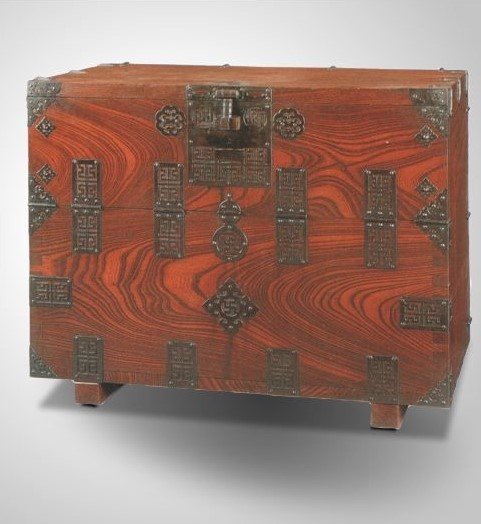

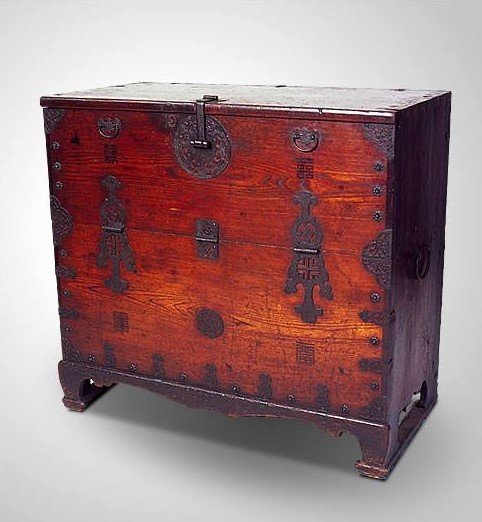
1 – ANTIQUE FURNITURE:
This category comprises pieces from the early 18th century to the early 20th century, made in the pure Korean style, and many of them remain in their original condition with very few restorations.
These pieces are primarily found today in various auction houses, galleries, shops, museums, and private collections.
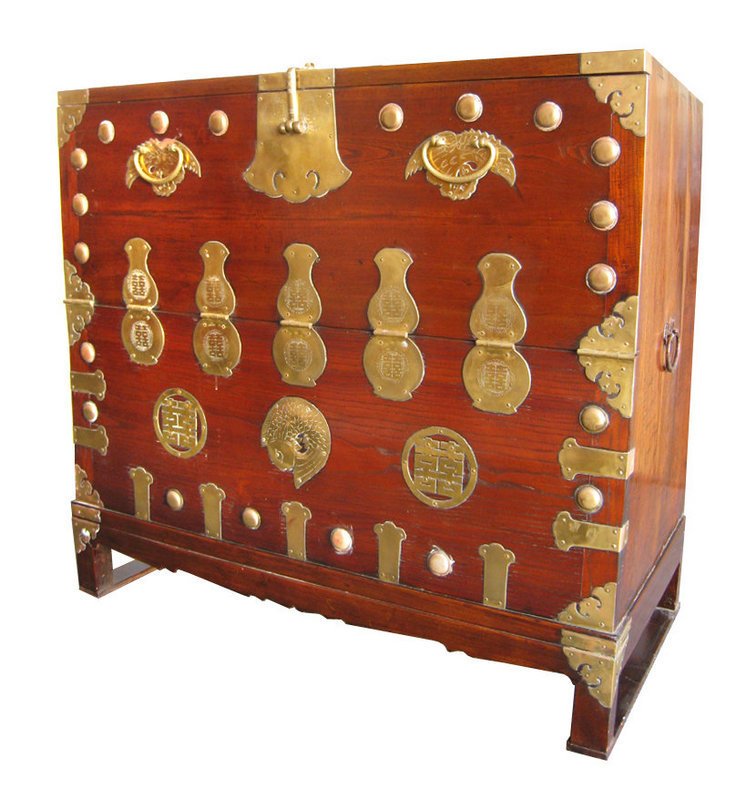
2 – RESTORED FURNITURE:
Most of these pieces date back to the early to mid-20th century.
While their original design has been preserved, restoration was often necessary, including the replacement of metalwork, rebuilding legs, and other parts. As a result, their value is generally lower compared to the group mentioned above and depends on the extent of restoration that has been undertaken.
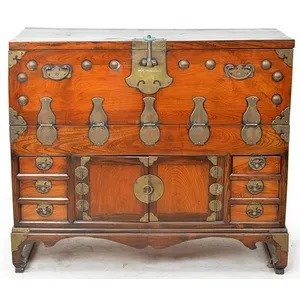
3 – RECONSTRUCTED FURNITURE:
These pieces were created by rebuilding old furniture bodies. The design was modified to make them suitable for modern-day use, primarily emphasizing their decorative value.
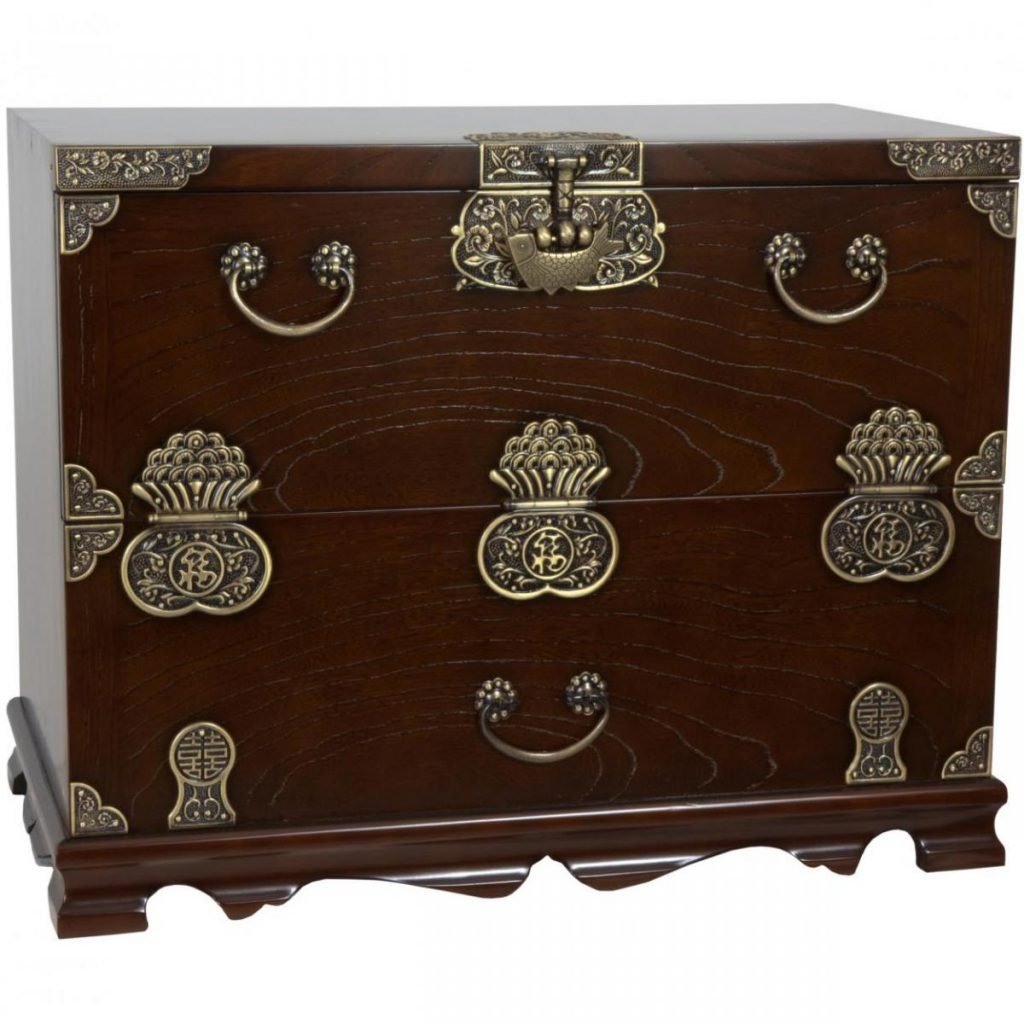
4 – REPRODUCTION PIECES:
Here, we classify two types of reproductions:
- Those made by carpenters using real wood and original joinery techniques.
- Mass-produced furniture in which solid wood has been progressively replaced by pressed wood covered with a very thin veneer.
ANTIQUE FURNITURE
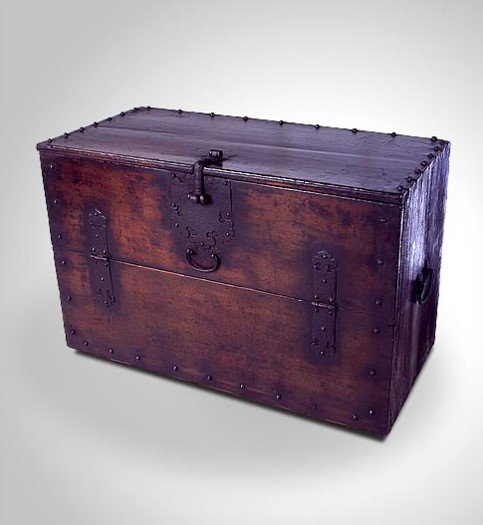
Pine wood, iron fittings. Oil finish.
Korea. Mid 19th Century.
H. 63 cm, W, 92 cm, D. 46 cm. Collection: “ANTIKASIA“.
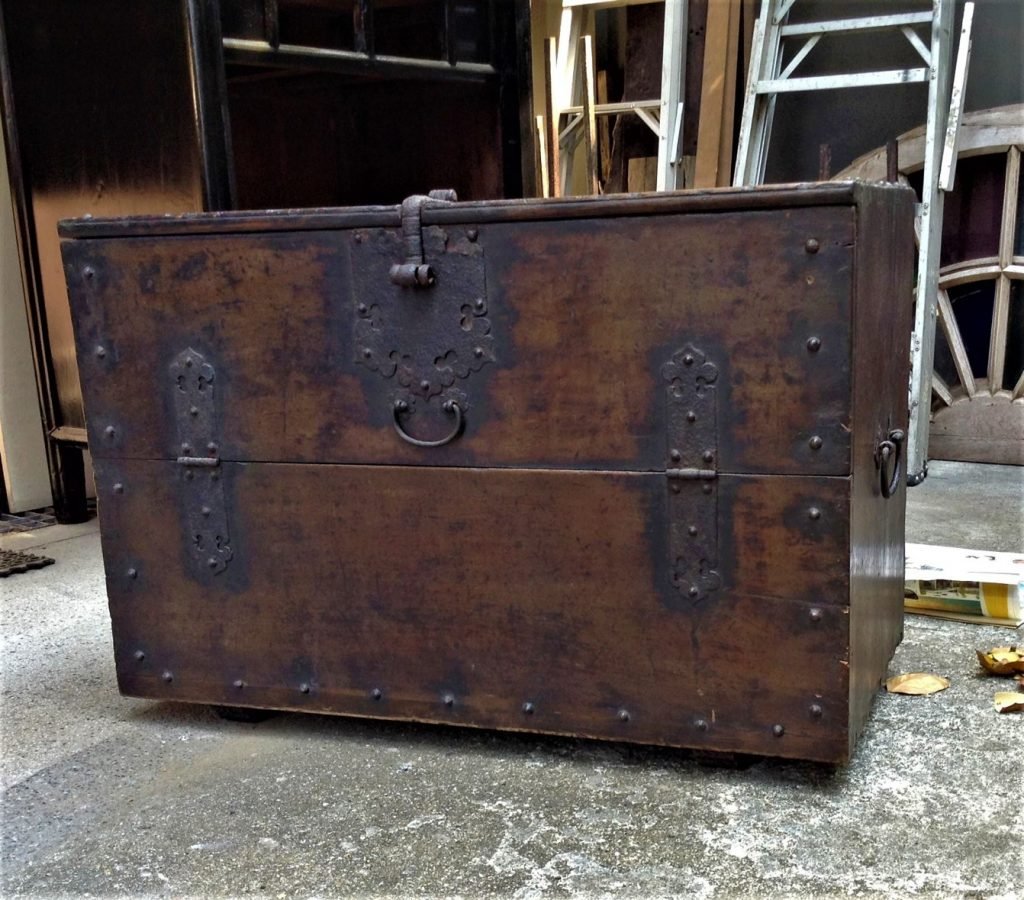
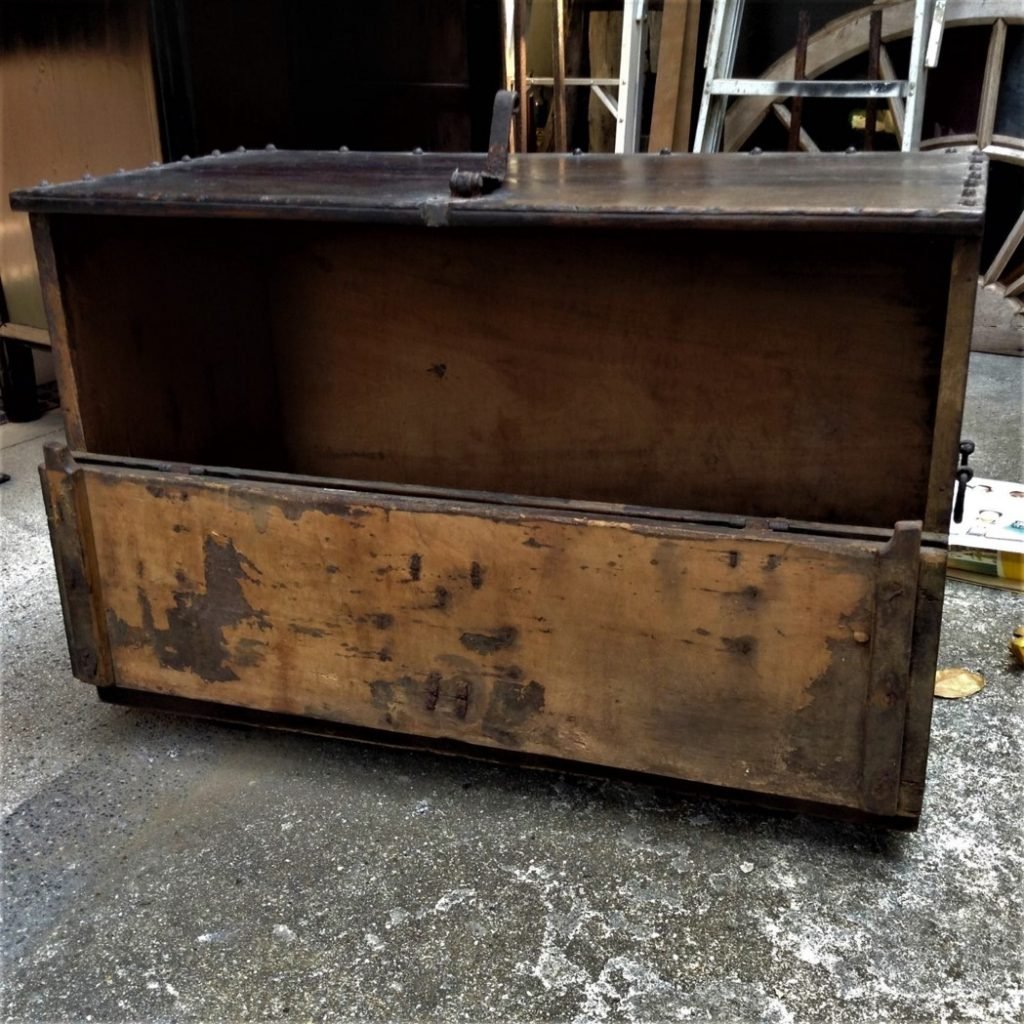
First, examine the overall design of the chest. Does it match that of an original piece? Look for any parts that may have been altered. Open the chest and take a moment to smell the interior. Inspect the surface closely. Has it been cleaned? Is there any evidence that the inside of the chest has been lined with newer paper?
Don’t just look at the piece; also, smell and touch it.
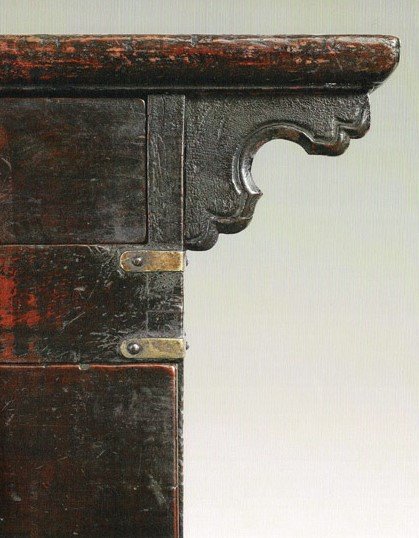
There is a way to determine whether an antique has been refinished, and this is crucial because antiques with their original finish are more valuable than those that have been refinished.
Turn the piece upside down or onto its back, and examine it for any telltale drips and runs that might suggest the piece has been reworked.
Expect to discover signs of aging on older pieces.
The wood on a new piece will appear flat and smooth.
Other indications may include black marks from water, nicks and dings on corners, and even wormholes.
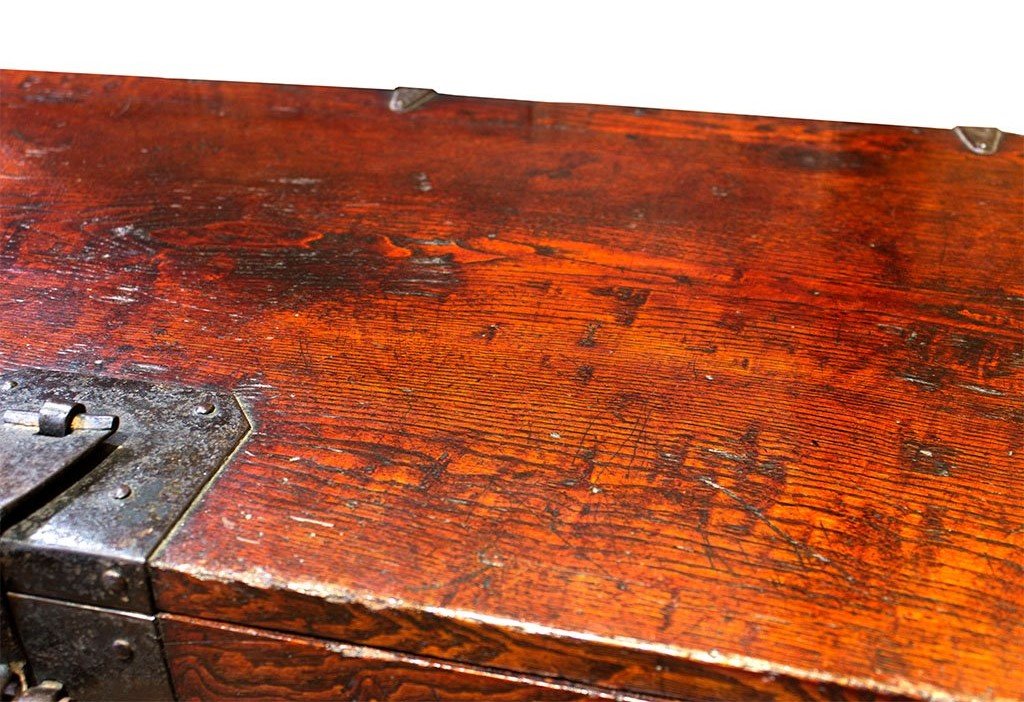
Examine the hardware to see whether it displays signs of aging. Each piece of hardware should be at least slightly different from the others, while the hardware on a new piece will be uniform.
The black stains around the hardware are dull and irregular. The nails were handmade, and each has different sizes and shapes.
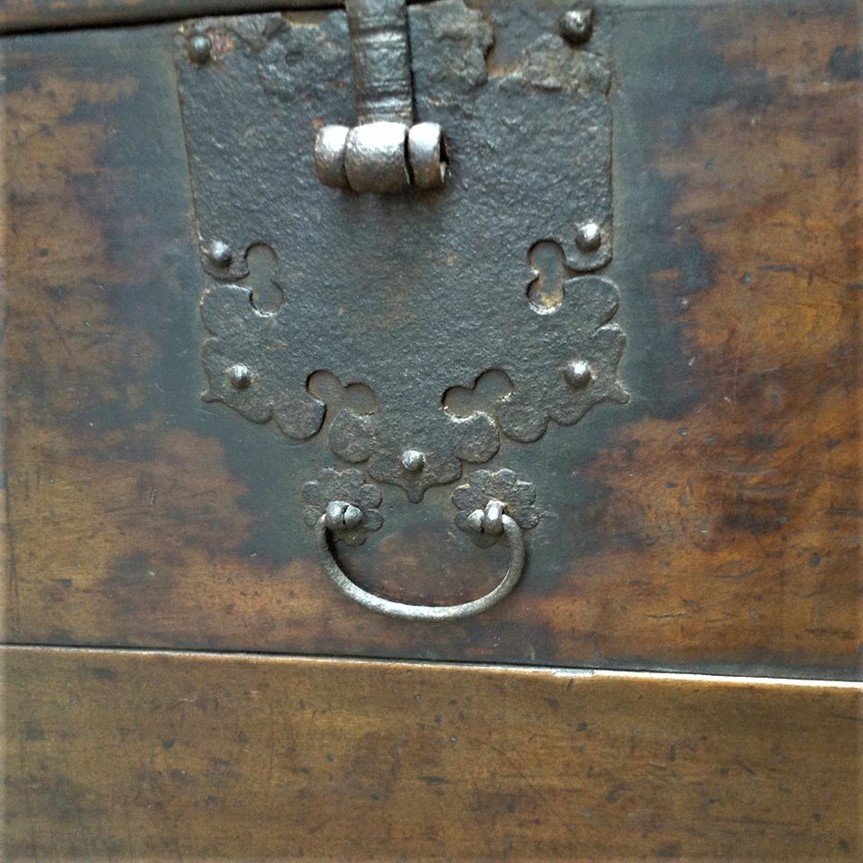
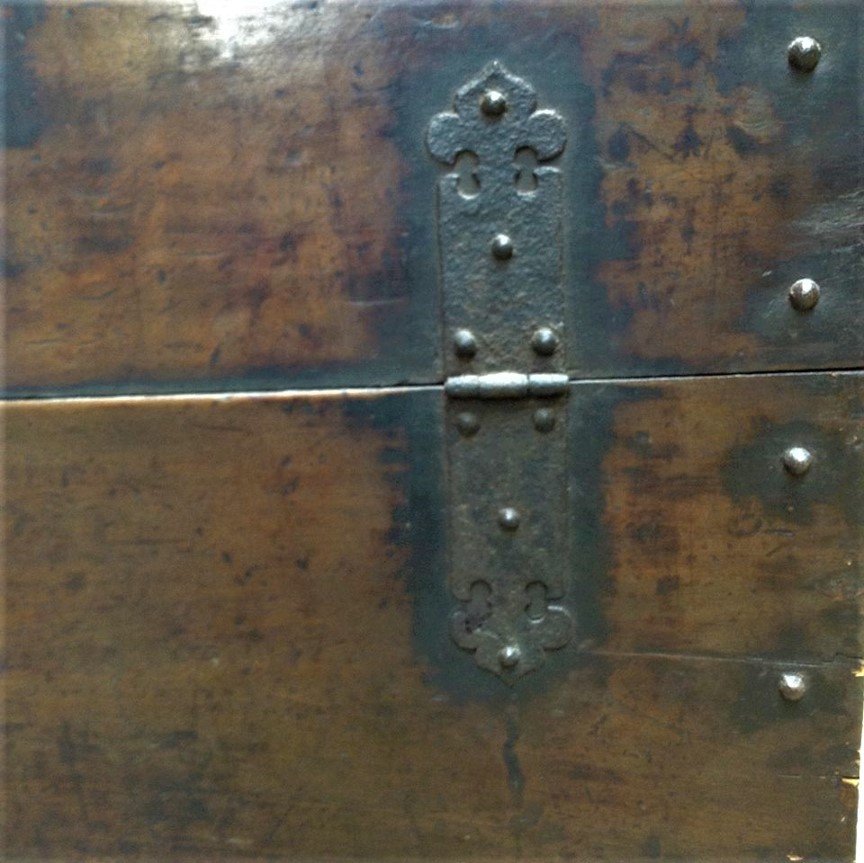
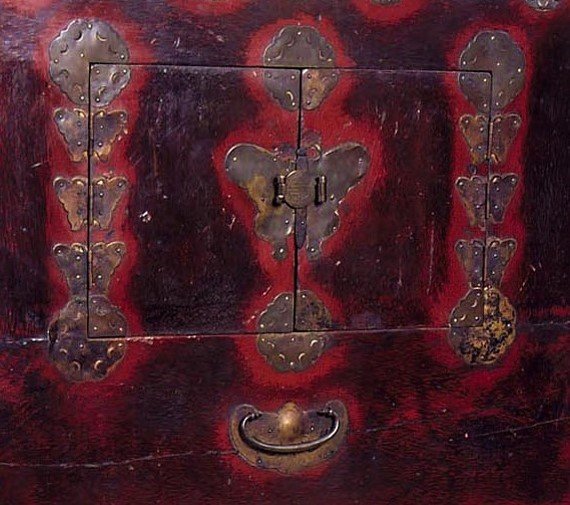
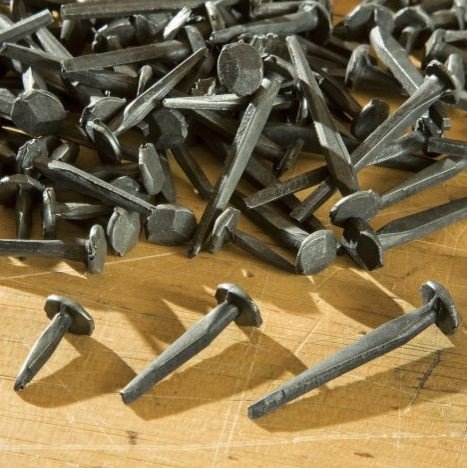
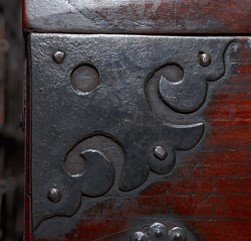
New hardware has been placed on this chest. Iron plate edges are too sharp and the black stain around the plate seems to even.
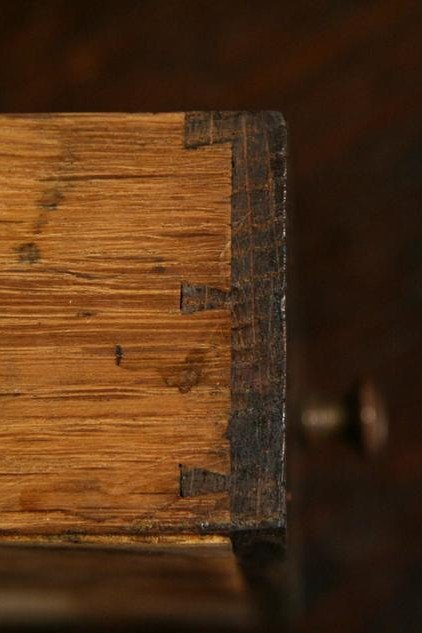

Take out drawers and examine bottoms and sides for signs of wear.
The indication that it’s been opened times over the years.
RESTORED FURNITURE
Pieces which follow were usually found in poor condition and restoration was necessary.

Nong.
The drawer fittings are not in Korean style but rather in Japanese style and were added during the restoration.
The legs were replaced, and a cleaning was performed, causing some of the patina to disappear.
Two level chest.
The doors have been replaced with a lattice work, which was not common in traditional Jang furniture. The bottom legs have also been replaced.
The chest was cleaned, and a new color was applied. The fittings are new.
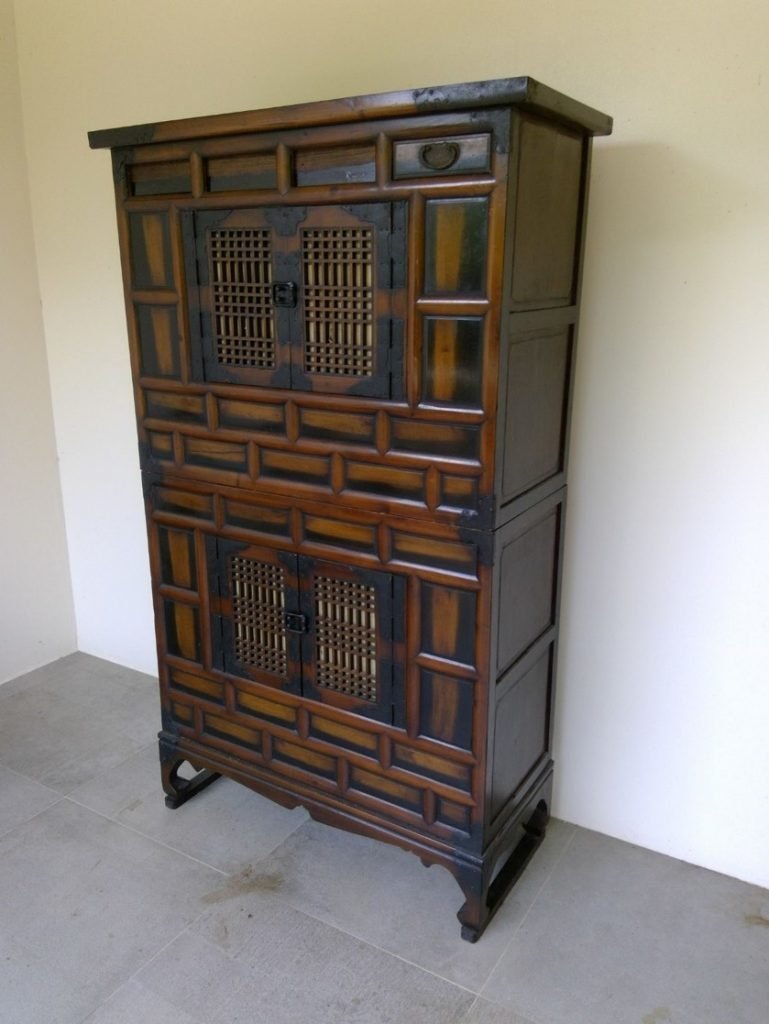
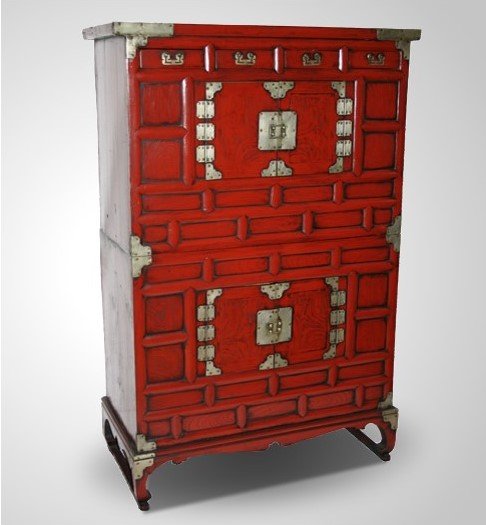
Two level chest.
This chest, made of elm and pine wood, was recolored with an unusual red paint. Red was primarily used by royalty but became very popular in the 20th century for export furniture.
The original broken legs were replaced.
Large Medicine chest.
The top and legs were replaced. New brass fittings were added to the drawers, along with new paper sheets bearing Chinese characters, which were labels for the stored Chinese medicine.
However, when you opened the drawers, there was a lingering smell and evidence of prior use.
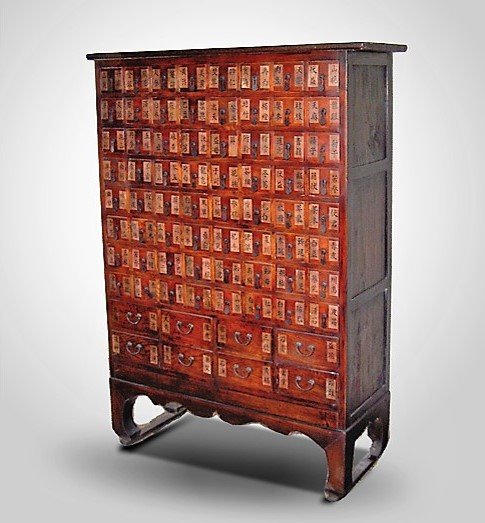
RECONSTRUCTED FURNITURE
To be able to identify these pieces, you need to acquire some knowledge of Korean original furniture shapes and designs.
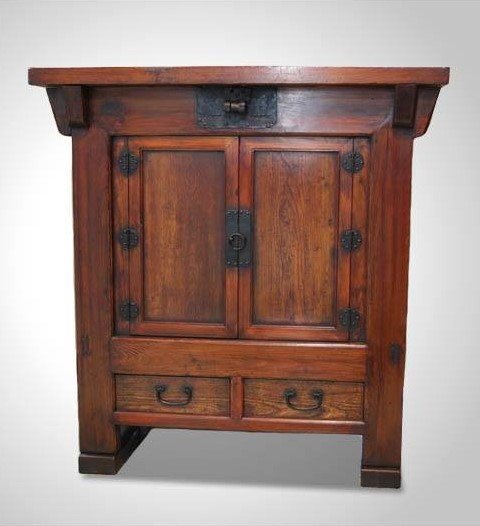
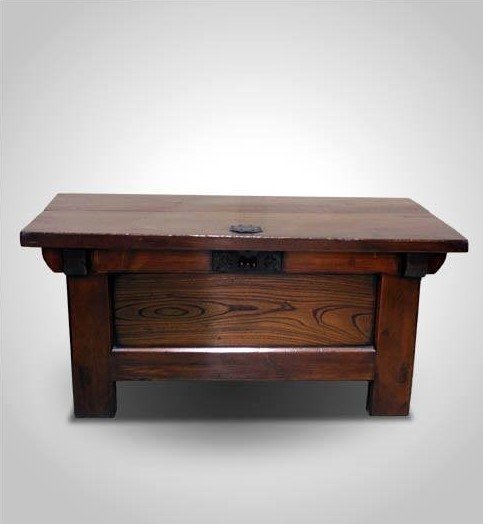
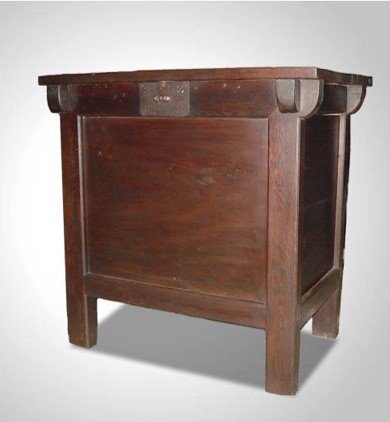
Kitchen chest used for rice storage. Pine wood body, elm front panel. Dark stain. Iron fittings.
H. 108cm, W. 113cm, D. 70cm.
Gyeonggi province, Korea.
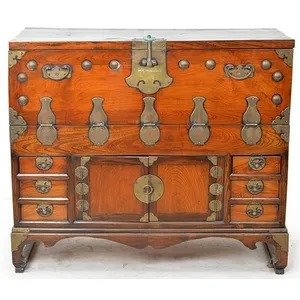
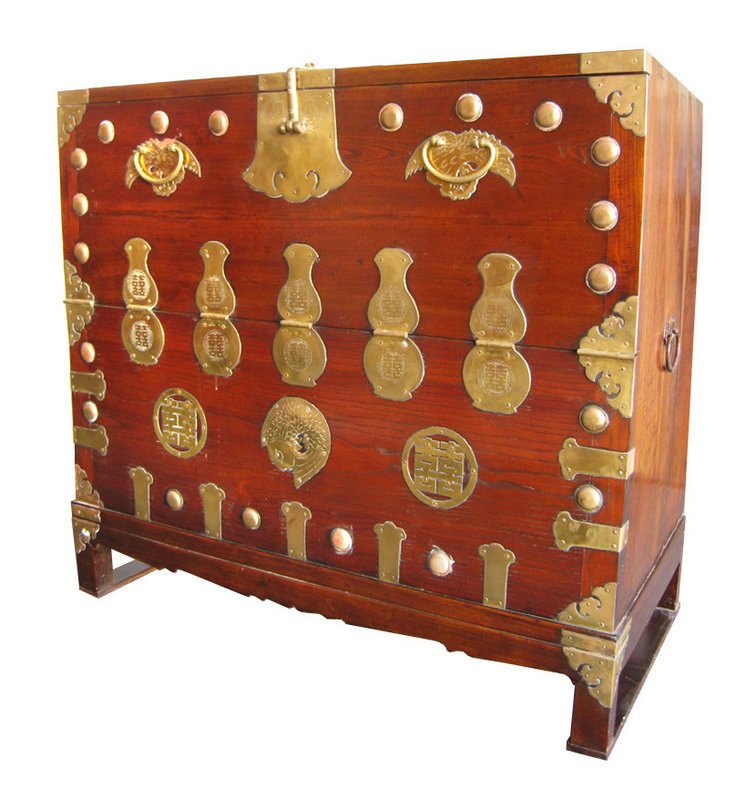
Original design with only one opening panel on the top front part. (Widely restored)
REPRODUCTION PIECES
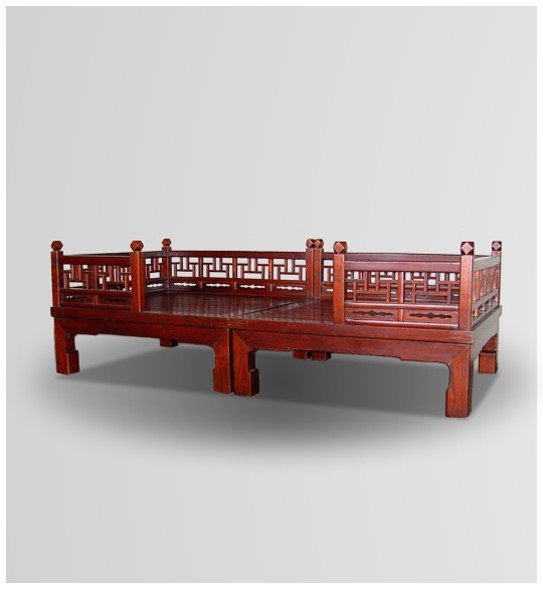
Original day bed were much smaller and built in one piece. Genuine piece are extremely rare as were used by wealthy nobles.
Here, you have an example of a reproduction piece made in China. Built in two sections of large dimension more adapted to modern use.
KOREAN MEDICINE CHEST
This chest, purchased in the late 1960s by my father during one of his trips to Korea, has remained in our family for years. As a young boy, with little knowledge about this faraway country I couldn’t even place on a map, I was impressed and quite astonished.
Years later, during a trip back to France, I decided to restore it, as it had been badly damaged during a move. With more knowledge at the time, I discovered the true identity of this particular piece.
Cracked wooden side panels revealed ‘new wood.’ The drawers were clean with no traces of use, and the wood borders were sharp. The yellow brass fittings were quite thin and machine-made. This piece was definitely a reproduction.
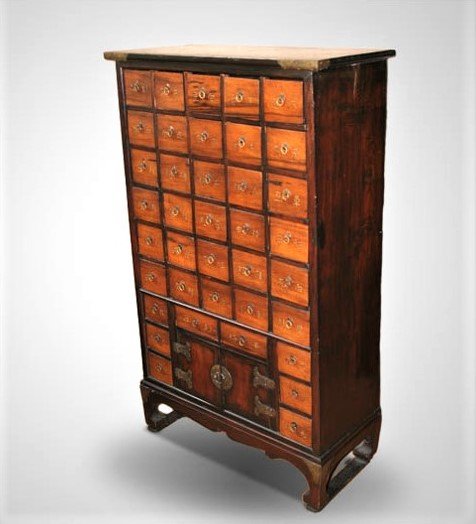
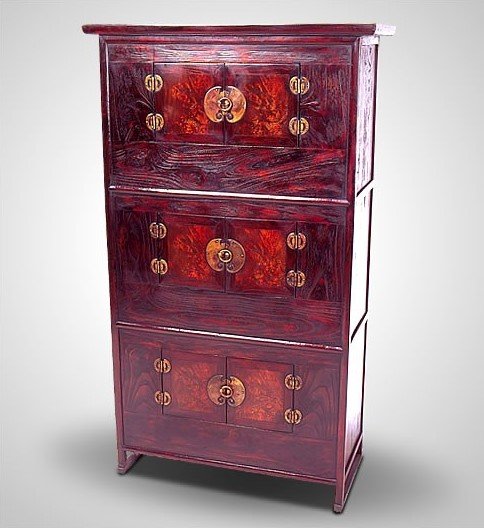
(frame), paulownia wood (body) and fine grained elm
wood doors panels. Fine yellow brass fittings.
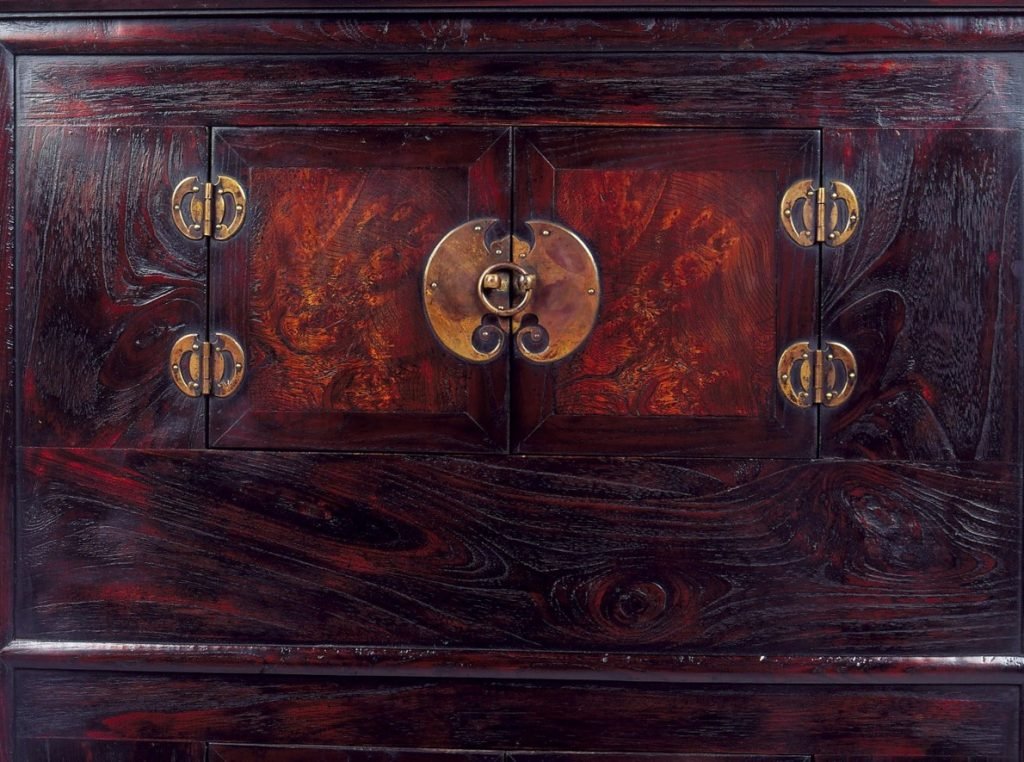
The chest is too narrow.
Top drawers are missing.
If you look closely, wood has no damages from use.
Fittings are too finely cut and do not
show any age
In this category, we have included chests known as “mass-produced” pieces. They bear a slight ‘Korean style,’ but their overall design has been modified to satisfy the demands of contemporary usage.
They are typically constructed from pressed wood, which is then covered with a very thin veneer (less than 1mm), usually elm. The finish is glossy, without any of the imperfections natural wood would reveal. The metalwork is made from thin, shiny yellow brass plates that tend to darken with age.
The interior is covered with new printed paper of white or yellowish color.
Such pieces are quite heavy due to the main material in use (pressed wood). They primarily hold decorative value, which might depreciate over the years due to demand fluctuations. Once damaged, they are very difficult to repair because of the thin layer of veneer used to cover them.
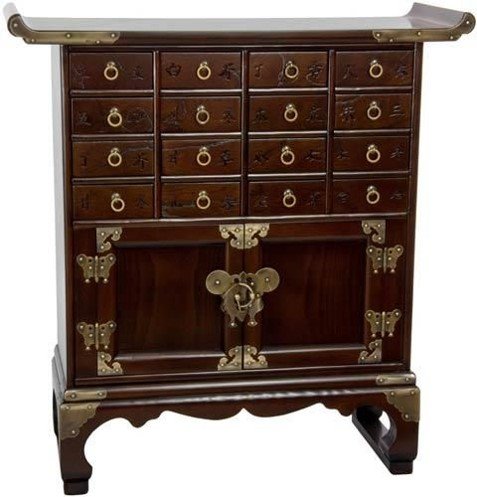
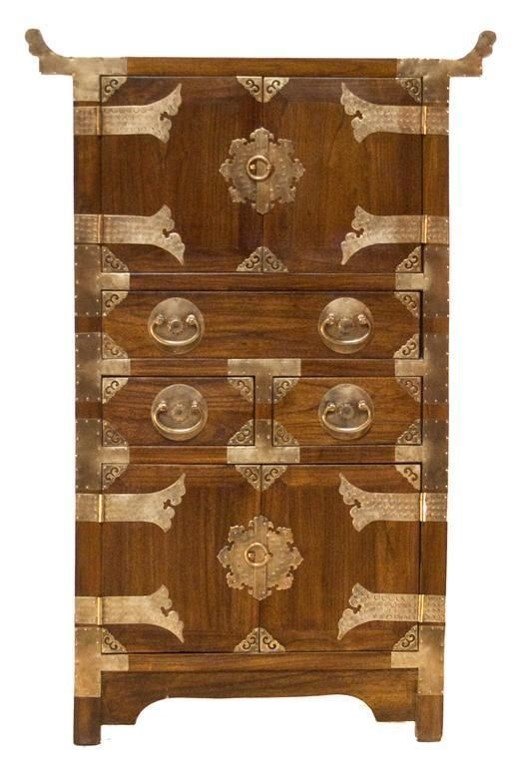
Press wood, elm veneer. Yellow brass fittings
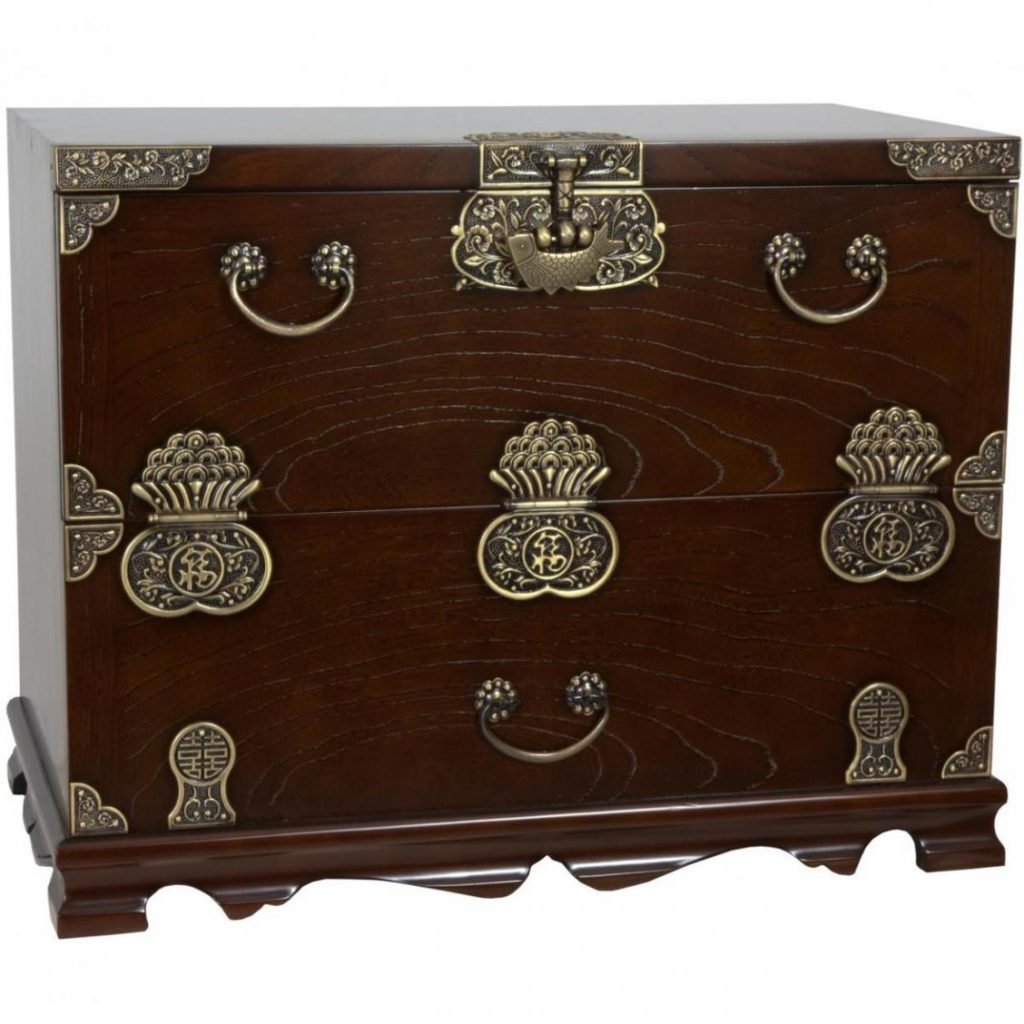
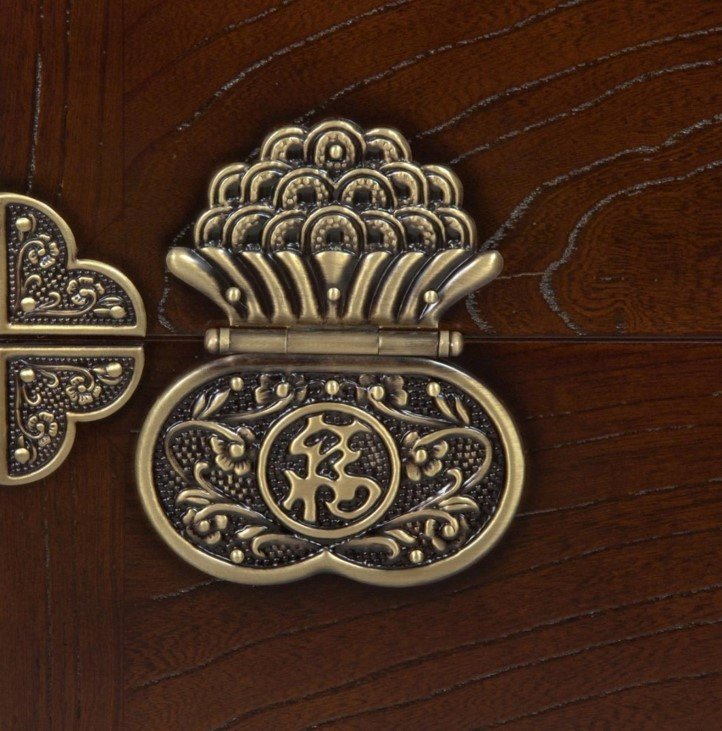
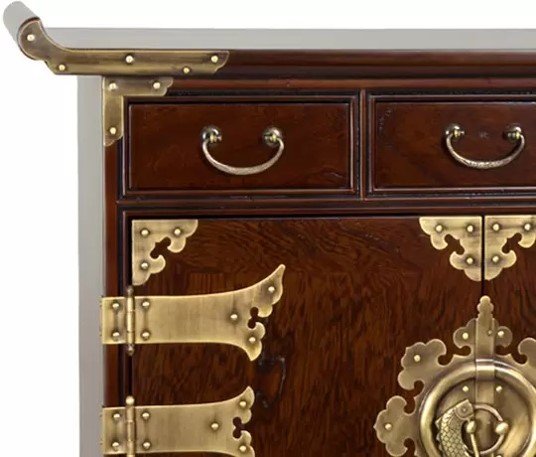
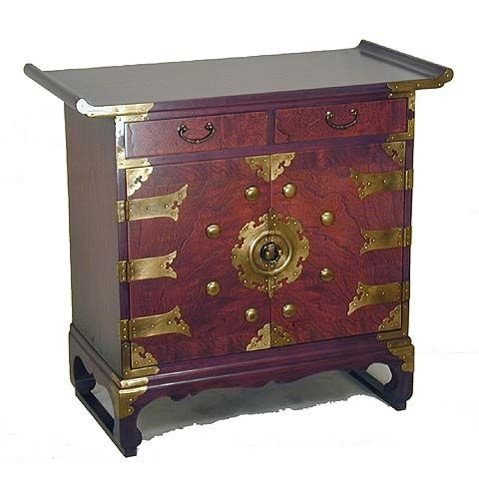
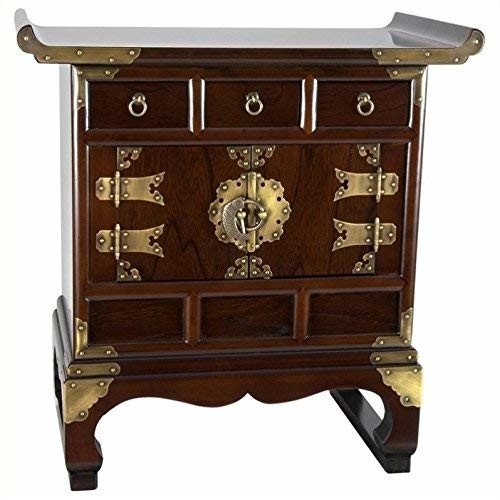
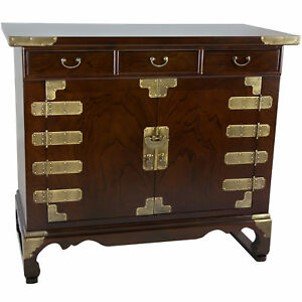
Small side chests. 3 photos ubove.
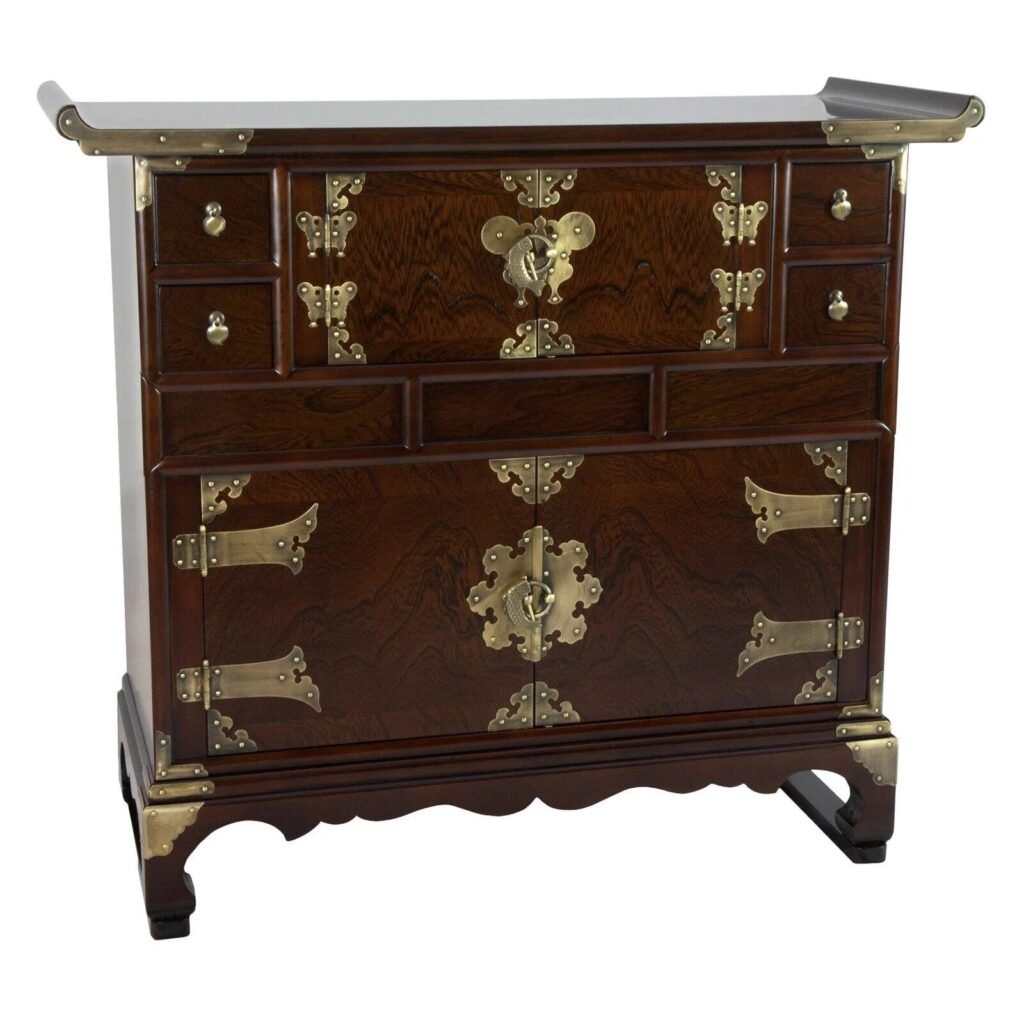
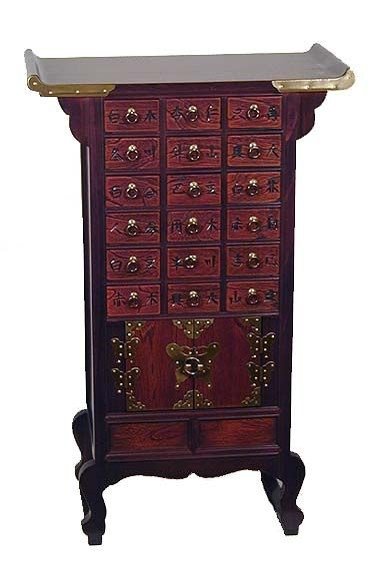
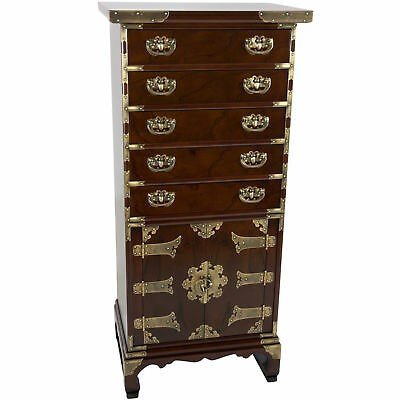
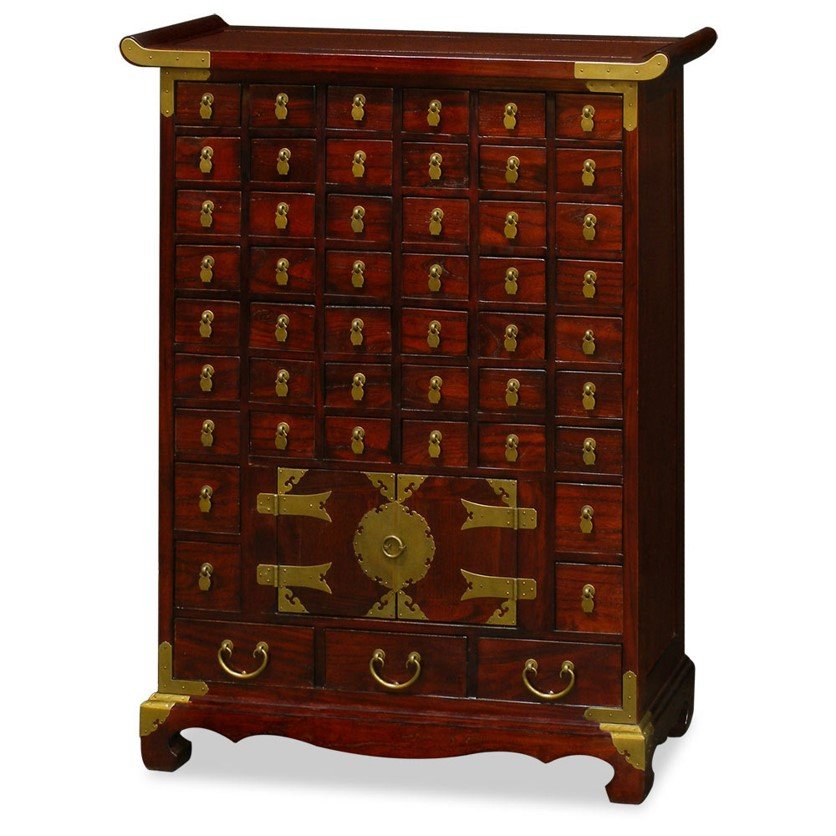
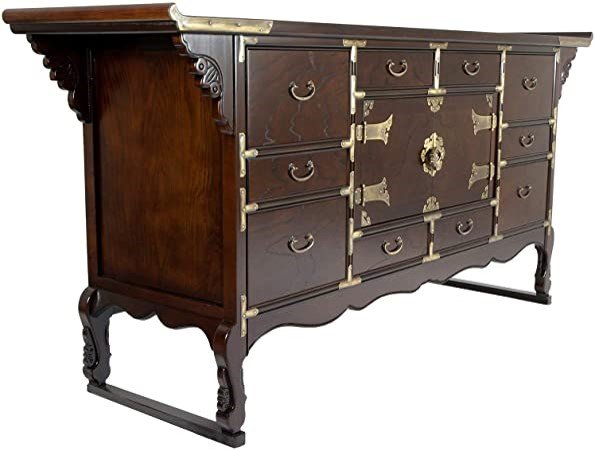
This design did not exist in traditional Korean Furniture.
This is a typical example of furniture built for modern usage.
Such as dining room buffet or entertainment chest to support a television.
Materials used are similar as previous illustrated pieces.
All those chests featured in the last photos are new (20th & 21th century)
and considered as decorative pieces.
APPENDIX 1:
In general, very few pieces of Korean furniture had tops with raised ends. This particular design was common on scholar’s furniture, such as small tables or document chests. It allowed calligraphy scrolls to be placed on the table and prevented them from unraveling. This design became fashionable in the 20th century and is found on many reproductions, including medicine chests and small side furniture. This detail can help you identify the furniture.

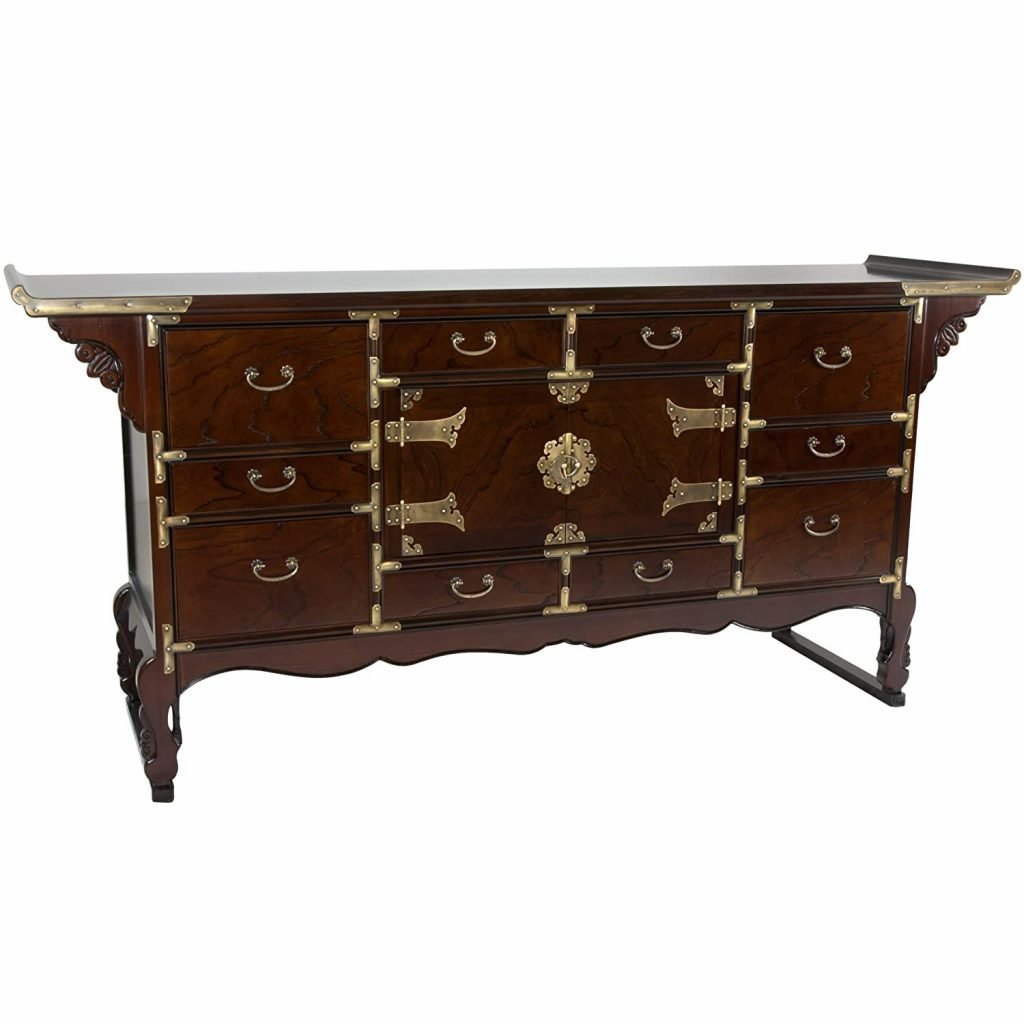
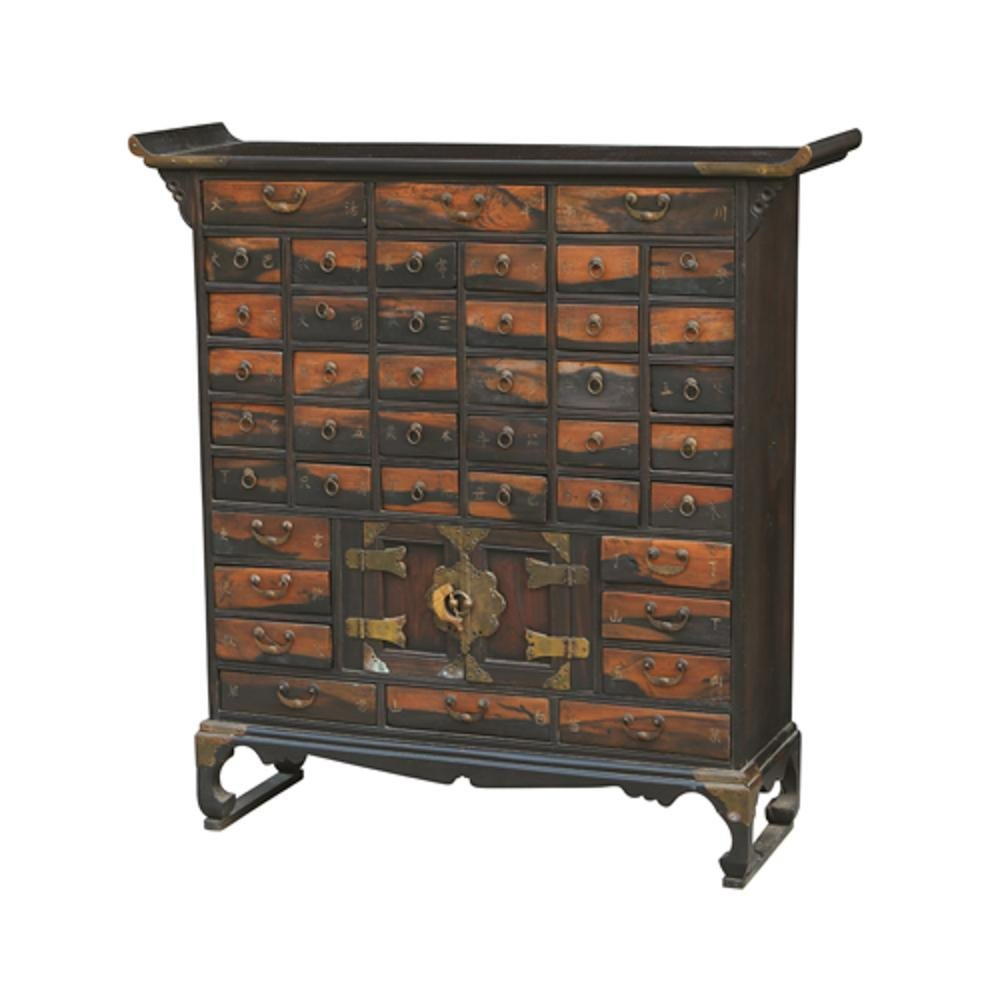
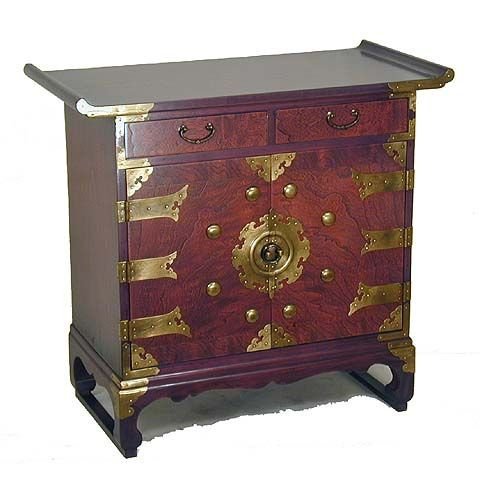
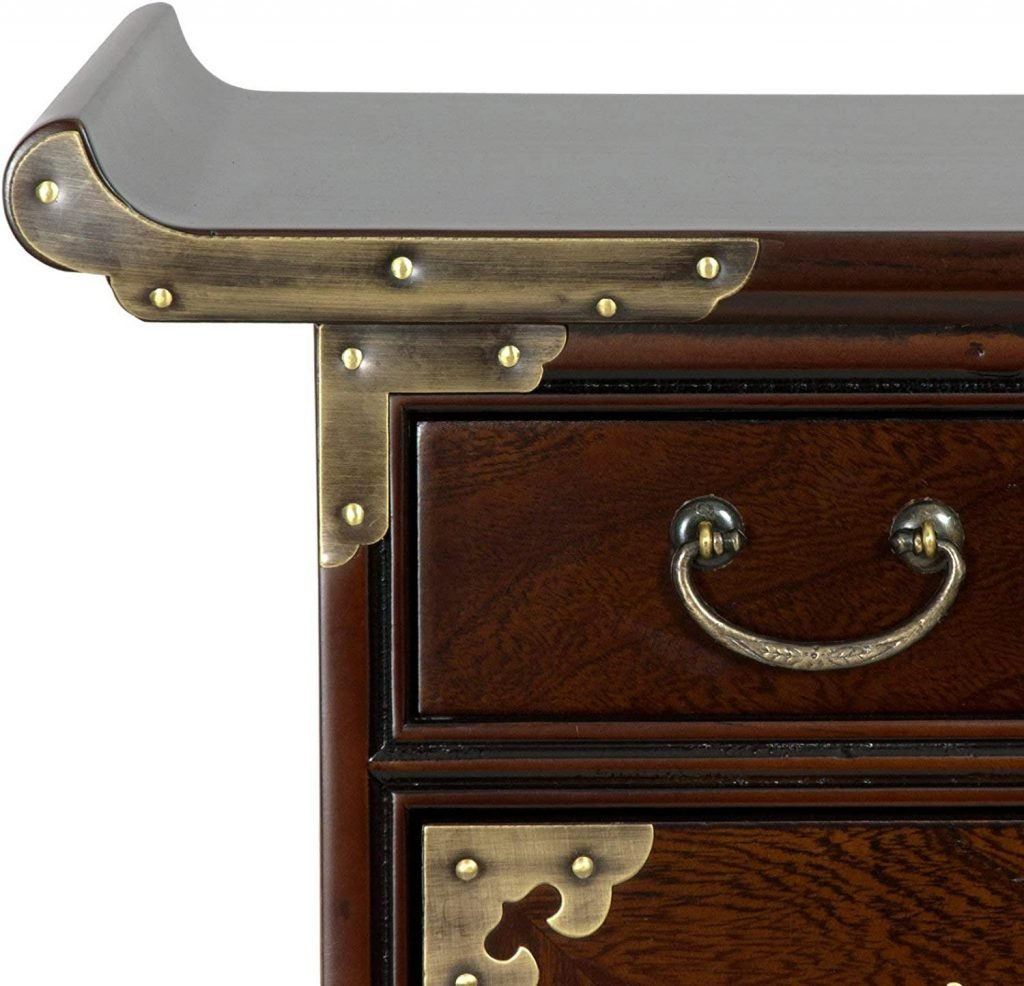
APPENDIX 2: SOME USEFUL TIPS WHEN SELECTING AND AUTHENTIFYING ORIGINAL KOREAN CHESTS.
Thanks to John Holstein, a long-time resident in Korea, and passionate of Korean antique furniture.
Authenticity
Use logic, and do detective work. These are a few tips, but discovery is mostly logic and common sense.
Is all the inside wood consistent color and age? Check out the wood planks, pillars and drawers.
Is any wood stained black? This is unusual in Joseon pieces, and is often done by restorers to disguise new wood.
Fittings: If the yellow brass fitting has a reddish tint, it means some aging product has been applied. If the color is a sharp or hard yellow or yellow-gold, it is probably new; old brass is mellow and soft.
Fittings: Are the edges of a fitting very sharp and regular? If so, it is likely that the fitting was cut with a machine, which Joseon Dynasty chest makers did not have. (Many authentic turn-of-the-century North Korean chests, though, have stamped ornamentation.)
Nails in fittings, nail covers, fittings: If some are uneven and do not have a smooth surface and then others are even and smooth, you know the latter are replacements. Joseon Dynasty craftsmen made their nails by hand. (Occasionally you will find mass-produced nails added later for reinforcement.)
Are bamboo nails used in the drawers? This was a Joseon widely used technique.
Is there wear on the bottom of the drawers? If there is not, the drawer is probably new (or, in rare instances, simply used very little).
Hinges: If there are any extra impressions on the inside wood around where the two-pronged out-bent nails fastened the hinge or fitting to the wood, the hinge or fitting has probably been replaced.
Hinges: Do the male and the female parts match perfectly?
Is the hinge-protector (where the female part would hit the front panel if the drawer were to drop) at exactly the right height?
Edge fasteners: Are they of consistent height and thickness and patina?
Finish on black metal: Is it a fresh black? If so, the black is just paint. You should be able to see age, in the form of wear and softness, in the metal.
Black around fittings and locks: This dark area is actually smudging from decades of use, and in a piece which is not original the dark color is applied to fake age. Authentic dark stain from patina is not a very black and it does not have definite borders.
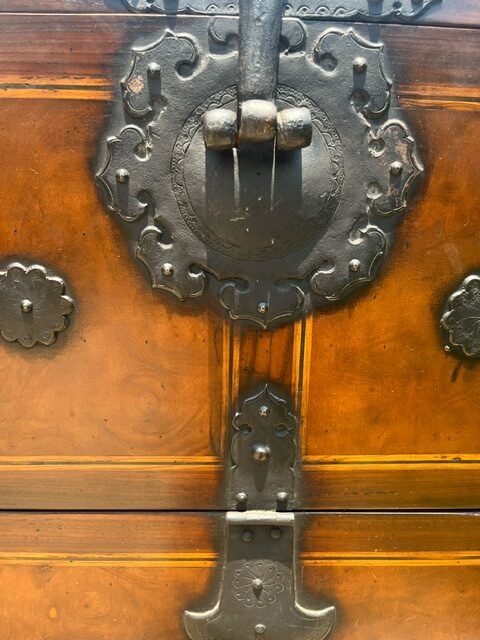
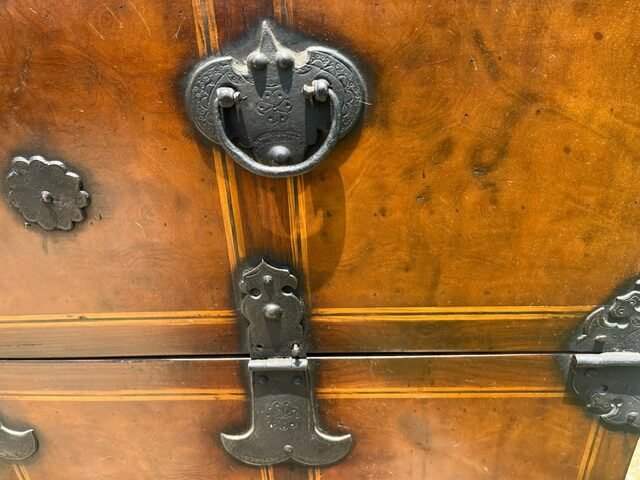
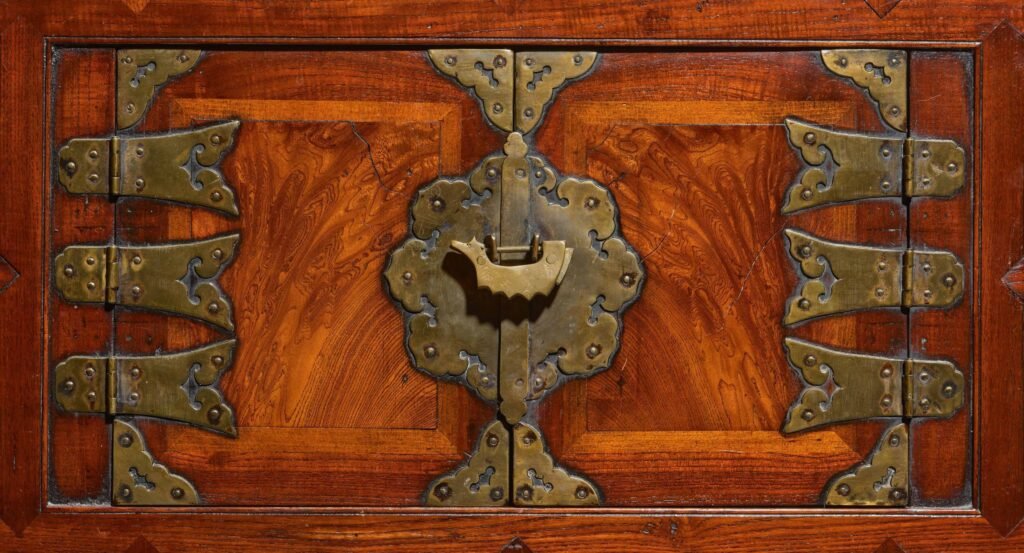

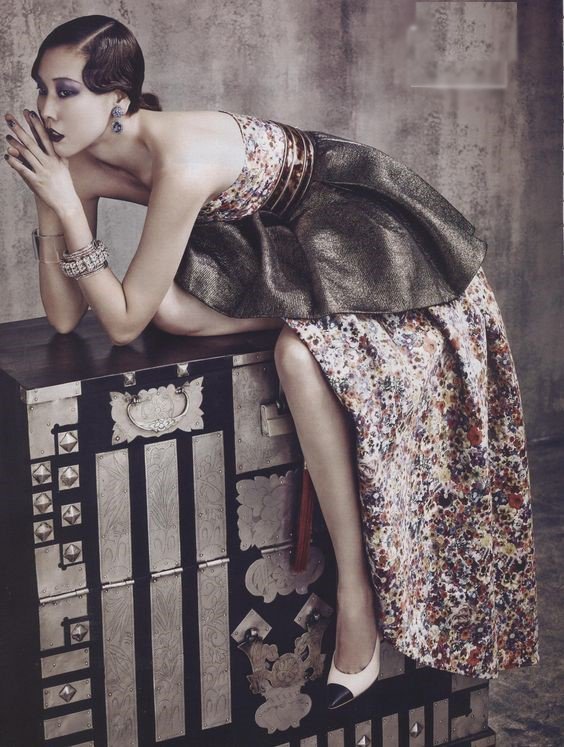
Tengo un mueble coreano antiguo , me gustaria datarlo y su valoracion , a que web les podria pasar las fotos.
Dear Sir,
You can send us photos to the following email address: tortuebangkok@gmail.com
Best regards
We recently purchased what we think is a Mid 18th century coin chest at an estate auction. Would you be able to help authenticate the piece if we were to take a few photos of it?
Probably please send us photos to: tortuebangkok@gmail.com.
May I please send you some photos of a chest I purchased recently? I’m not sure if it’s a reproduction or not. It has Chinese characters inside.
You are welcome to send us your pictures.
Hello. Thanks for this very informative piece. My chest was purchased on e bay with authenticity certificate, but I am unsure whether it’s an original. It’s unfortunately suffered a few knocks in transit. My decision to repair it would depend on whether it’s an original or not. Could I send you some pictures of my chest? Thanks
Yes, please do. Send photos to tortuebangkok@gmail.com
Best regards
Yves